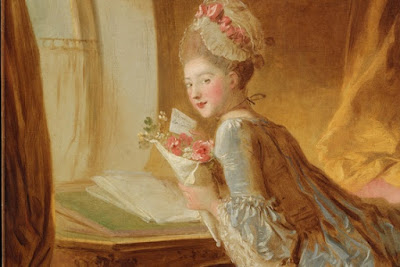Julia Wolkoff
Jean-Honoré Fragonard, The Stolen Kiss, late 1780s. Image via
Wikimedia Commons.
The art of seduction has been disgracefully debased in these last
few decades. Recently, it’s been reduced to the rather uncivilized mating call
“Netflix and chill,” an insinuation of sex sans flirtatious preamble—or any
effort at all. Must our standards for romance be so low? Our regard for the
pleasures of temptation and delayed gratification so warped by modern
technologies?
Let this Valentine’s Day offer a much-needed reminder to take note
of paramours past. As the French constantly remind us, there’s no better
teacher for a masterclass in love. In the 18th century “age of allurement,”
these coquettish enfants terrible practically invented erotic play with
seduction techniques that reached dizzying extremes.
Today we might think of seduction as a series of finite actions
(sit on couch, load Netflix, euphemistically “chill”) that, without much
additional preparation, can lead to the one ultimate goal (sex). But to the
refined Rococo lover, seduction was part of an elaborate game of cultivated
sociability in which pleasurable experiences were mediated by equally
pleasurable, luxurious environments.
In the upper echelons of 18th-century French society, a
sophisticated taste in interior decoration underlaid immense social—and
sensual—power. Not much has changed, in the sense that high-end decor can
signal a refined sensibility—as well as, of course, a big bank account. Indeed,
the extravagantly luxurious lifestyle cultivated among the elite during this
time is exemplified by fashion, furniture, and objets d’art so ridiculously
opulent that they seem to explain the proletariat revolution with a single
glance.
But such vanities played an integral role in facilitating both
status and pleasure—a state, as Mimi Hellman writes in her excellent 1999 essay
“Furniture, Sociability, and the Work of Leisure in Eighteenth-Century France,”
that was a kind of “social currency.” One catalyzed pleasure first with social
graces by delighting company with a carefully cultivated charm, and secondly,
by flawlessly executing proper etiquette, especially in creating elegant
gestures while handling complex furnishings. The third—and perhaps most
crucial—step was to craft perfectly sumptuous interiors: one’s premiere stage
for social performance.
In this arena, courtship was conceived not as “a pursuit of overt
sexual expression, but rather an exchange in which individuals sought to engage
and delight each other with an artfully conducted repertoire of pleasing poses,
gestures, expressions, and conversation,” Hellman writes in the catalogue for
“Dangerous Liaisons: Fashion and Furniture in the 18th century,” a 2004
exhibition at the Metropolitan Museum of Art. The inventive show elucidated
these intimacies through a choreographed interplay of fashion, furniture, and
the decorative arts. In the Wrightsman Galleries period rooms, curators
arranged erotically charged vignettes—a stolen caress during a music lesson; a
flirtatious glance while playing cards—with mannequins styled in silk
boutonnieres and flowering robes à la Française.
The exhibition was not only an enticing display of treasures
normally isolated in separate curatorial departments, it was also an
opportunity to appraise the domestic interior—and the centrality of luxurious
things—to the concept of elite identity in France. The Louis XVI–style period
rooms in the Wrightsman Galleries capture the self-indulgent atmosphere
inherent to the time period, when fashion and furniture were intended to not
only delight, but arouse. Each room offers a holistic sensory experience, with
walls covered in carved paneling or expensive textiles; gleaming mirrors that
frame marble mantelpieces and reflect curving, gilded-bronze chandeliers and
porcelain vases; and matching sets of silk-upholstered chairs, each designed
for specialized leisurely activity. The complex mechanisms and rules for
gracefully maneuvering such decorations, however, provided opportunities to
show off beguilingly sophisticated charm (or a stockinged ankle)—as well as the
potential for embarrassing blunders that would reveal a discomfort with the
codified leisure of the nobility.
“Objects were like extensions of the body, part of a wardrobe that,
correctly worn, could turn the activities of elite existence into dances of
artful persuasion,” Hellman writes in “Interior Motives: Seduction by
Decoration in Eighteenth-Century France.” The literature of the time reflects
this libertine attitude. In Jean-François de Bastide’s odd erotic novella “The
Little House: An Architectural Seduction,” which inspired the Met show, the
oily Marquis de Trémicour relies on the power of the luxurious objects that
adorn his maison de plaisance to woo the women he brings home.
In this tale, the marquis has ensnared the young and innocent
Mélite. As he gives her a tour of the house, Mélite feels her resolve weaken
through evermore elegantly appointed rooms. (“Indeed, so voluptuous was this
salon that it inspired the tenderest feelings, feelings that one believes one
could have only for its owner.”) Mélite becomes so distraught by the beauty of
the house and the marquis’s impending advances that she almost collapses onto a
bergère, an upholstered armchair that offers the wily Trémicour the opportunity
to get closer to her. He throws “himself at her knees,” trapping her in his
gilded cage until she finally loses “the wager” and sleeps with him…………..
https://www.artsy.net/article/artsy-editorial-valentines-day-rococo-era-lesson-setting-mood?utm_medium=email&utm_source=16011096-newsletter-editorial-daily-02-14-19&utm_campaign=editorial&utm_content=st-V


No hay comentarios:
Publicar un comentario